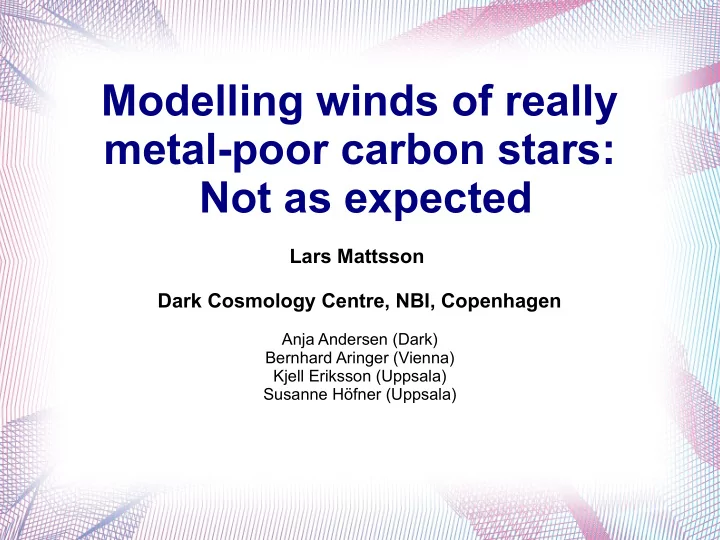

Modelling winds of really metal-poor carbon stars: Not as expected Lars Mattsson Dark Cosmology Centre, NBI, Copenhagen Anja Andersen (Dark) Bernhard Aringer (Vienna) Kjell Eriksson (Uppsala) Susanne Höfner (Uppsala)
Carbon stars
Mass loss
Low metallicity Sloan et al. (2008, Science, 323, 354)
Model
Model Mattsson et al. 2008, A&A, 484, L5
Model “Standard” model star: ● Mass: 1 M 8 ● Luminosity: log(L/L 8 ) = 3.85 (~ 7080 solar lum.) ● Surface temperature: T eff = 2800 K ● Carbon excess: log(C-O) + 12 = 8.50
[Fe/H] = 0.0 3.77 10 -6 15.6 0.248
[Fe/H] = -0.5 3.55 10 -6 14.0 0.229
[Fe/H] = -1.0 3.17 10 -6 13.4 0.218
[Fe/H] = -2.0
[Fe/H] = -2.0 Ballistics!
[Fe/H] = -2.0 Does a higher luminosity do the trick?
[Fe/H] = -2.0 Does a higher luminosity do the trick? Nope!
[Fe/H] = -2.0 Log(L/L 8 ) = 4.15
[Fe/H] = -2.0 But changing the effective temperature...?
[Fe/H] = -2.0 But changing the effective temperature...? Not a chance!
[Fe/H] = -2.0 Mattsson et al. 2010, A&A, 509, A14
Molecules Molecular opacity may change this scenario: O-enhancement: C + O → CO H + O → H 2 O, OH ?? N-enhancement: H + N → NH 3 H + N + C → HCN
Conclusion and open questions ● There exist a critical metallicity below which the necessary conditions for dust nucleation cannot be met. ● O/N-enhancment may improve the conditions for nucleation, but the critical metallicity seems inevitable. ● If these stars have no dust-driven winds – how do they lose their mass? Is there another mechanism? ● Or do they not lose mass and go ka-boom as some peculiar type of Type I-ish supernovae? ● Any better ideas?!?
Recommend
More recommend